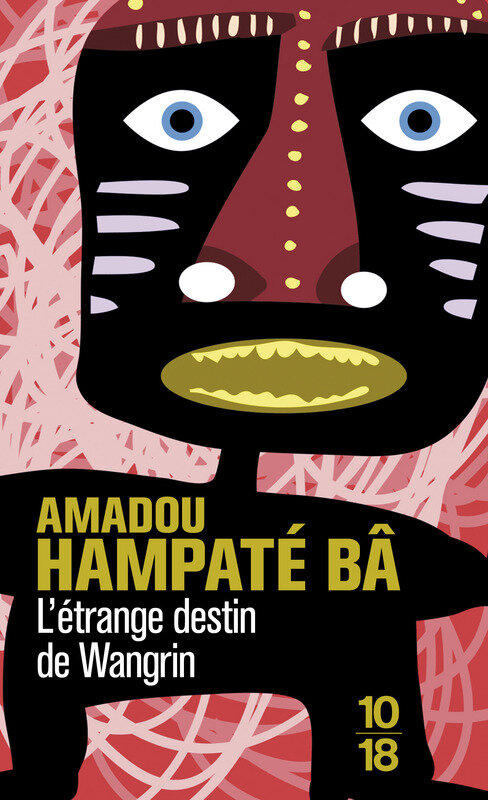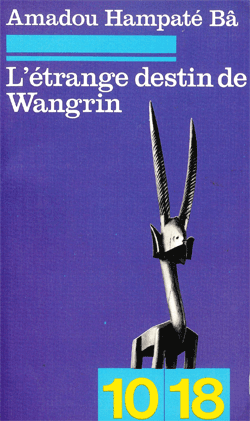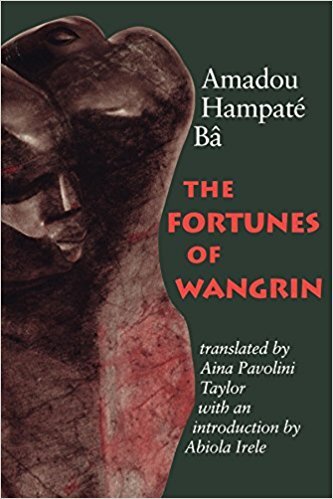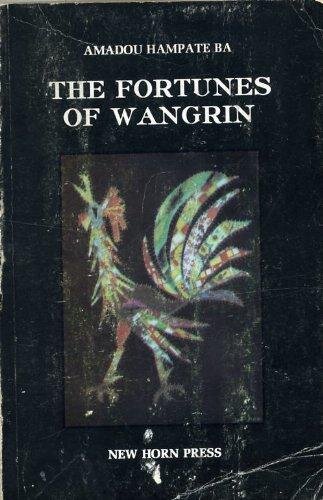The Strange Fate of Amadou Hampaté Bâ in the Anglophone World
Amadou Hampaté Bâ. Image sourced from Le Monde.
By all accounts, Amadou Hampaté Bâ (1901–1991) ranks among the giants of African literature. This would no doubt remain true even if no other work could be credited to his name aside from his one and only novel, L’Étrange destin de Wangrin ou Les roueries d’un interprète africain (The Strange Fate of Wangrin, or the Cunning of an African Interpreter), which originally appeared in 1973 and received the prestigious Grand Prix de Littérature d’Afrique Noire in 1974.
But Hampaté Bâ’s reputation rests on a much wider base of accomplishments. In addition to penning what is indisputably one of the greatest African literary works of the twentieth century, Hampaté Bâ also spent decades researching and recording Fula (or Fulani; Peul in French) history, culture, and oral tradition. Following nearly twenty years of service within the colonial administration, Hampaté Bâ’s life changed dramatically in 1942, when French naturalist and explorer Théodore Monod invited him to join the Institut Français d’Afrique Noir (IFAN). Monod had served as the director of IFAN since its founding in 1938 in Dakar, Senegal. The institute’s primary mission was ostensibly ethnological — ostensibly because, despite aiming to study the languages, histories, and cultures of African peoples under French colonial rule, IFAN also served more paternalistic goals, such as providing the necessary understanding of West African peoples that would enable the French to establish a more effective mode of indirect rule over them.
IFAN’s imperialist undercurrents notwithstanding, Hampaté Bâ applied himself assiduously to his ethnological research, traveling throughout West Africa to gather information about local stories and customs. Over the years, he assembled a vast personal archive that he would draw from throughout his decades-long writing career, beginning with the landmark publication in 1955 of his first work, L’Empire peul de Macina (The Fula Empire of Macina). Many additional works of history, biography, and ethnography appeared in the years that followed. This steady stream of research and writing earned Hampaté Bâ a place on the UNESCO executive council in 1960, and he served as a cultural ambassador on that council until 1970, working hard to win African oral traditions recognition as significant artifacts of the world’s cultural and literary heritage. In his later life he even became a diplomat, serving as the Malian ambassador to Côte d’Ivoire.
Perhaps more than for anything else in his long career, it is a comment Hampaté Bâ made while in the service of UNESCO that made him an international name: “In Africa,” he declared, “each time an old person dies, it’s a library that burns down (En Afrique, chaque fois qu’un viellard meurt, c’est une bibliothèque qui est brûlée). Since its initial utterance, this quote has appeared frequently to bolster claims for the value of African oral traditions, and it has become so ubiquitous that it is is often wrongly attributed, if attributed at all. Strangely, Hampaté Bâ’s most famous remark seems to have transcended its speaker.
This is certainly more often the case in the English-speaking world than in the French-speaking one, where most of Hampaté Bâ’s works are still in print, or at least moderately accessible. By contrast, his work remains relatively unknown and under-read in anglophone circles. Aside from his UNESCO comment, Hampaté Bâ’s name is often solely associated with his only novel novel, which received a sparkling translation by Aina Pavolini Taylor titled The Fortunes of Wangrin (1987, Indiana University Press). The only other work that has been translated into English — and that remains widely available — is Vie et enseignement de Tierno Bakar, le sage de Bandiagara, translated by Fatima Jane Casewit as A Spirit of Tolerance: The Inspiring Life of Tierno Bakar. (His retelling of a Fula initiation tale, Kaïdara, appeared in an English translation by Daniel Whitman in 1988, but has long been out of print.)
So what’s wrong? Why, given its importance in African letters, does Hampaté Bâ’s work continue to languish in obscurity in the Anglophone world?
Perhaps the most obvious answer is that the global literary market remains overwhelmingly dominated by novels. If a text doesn’t look, smell, and taste like a novel, publishers seem reluctant to touch it. In Hampaté Bâ’s case, the vast majority of his writing is more ethnographic than novelistic, which likely means that there may be little impetus to publish it, much less translate it. Scholars who study Francophone African literature probably don’t need to rely on such translations, and who else would read them anyway?
Novels undoubtedly sell better and reach a wider audience than more highly specialized ethnographic works, but that still doesn’t explain why Anglo-American readers — and particularly those with an active interest in African literatures — often do not know The Fortunes of Wangrin. It’s generally true that Francophone texts tend to get short shrift in Anglophone classrooms, which tend to privilege representatives from the English-language African canon. Having been published by an academic press, it is also possible that the translation’s price tag ($24 in paperback) makes it less appealing for undergraduate syllabi, not to mention for average readers.
Another possible reason that The Fortunes of Wangrin continues to have a modest Anglophone readership may be that it isn’t all that recognizable as a novel. Abiola Irele expresses as much in his introduction to Taylor’s translation, where he points to this as perhaps Hampaté Bâ’s most important achievement:
It does not take much reflection to understand that [The Fortunes of Wangrin] does not conform to the conception of the Western genre [of the novel] as defined by Ian Watt, for example, with its emphasis on realism and its narrow psychological interest. Samba Dieng’s term conte historique comes close to suggesting the nature of the work, its integration of the traditional moral fable with a historical narrative. . . . The truth, however, is that the variegated character of Hampaté Bâ’s work challenges classification. His achievement consists in the creative adaptation of mode to material, reflected here in the complex narrative procedures employed to give expression to the multiple levels of an expansive creative imagination.
Irele’s point about classification is an important one, as the successful marketing of literary translation seems so much to depend either on the translated text clearly belonging to a recognizable genre or on ready comparisons between the original author and other writers who are more famous in the target language (even if they themselves are only known through translation). But The Fortunes of Wangrin defies both of these tactics. Despite recounting Wangrin’s “project of self-realization,” as Irele puts it, the novel is not a Bildungsroman. Likewise, the mixture of the supernatural and the realistic may look like what’s called magical realism, but in truth is really more a reflection of African realities. The episodic narrative also seems kind of like a picaresque, but Wangrin isn’t quite a typical picaro (he’s neither of low birth nor of little breeding). Finally, unlike many African texts of the 1970s, Hampaté Bâ’s narrative doesn’t make use of “modernist” techniques, nor does it foreground the themes of alienation and irony—two things that seem crucial to the modern novel.
In addition to The Fortunes of Wangrin lacking a straightforward genre classification, the author himself lacks a ready analogue that would, through the reference, make his work seem more relevant to the European reader. Unlike Ousmane Sembène, who has been compared to Émile Zola, or Alain Mabanckou, who has been compared to Samuel Beckett, Hampaté Bâ remains incomparable, a distinctively African voice. For this reason, the “complex narrative procedures” Irele referenced above are perhaps more akin to those found in Amos Tutuola’s The Palm-Wine Drinkard or D. O. Fagunwa’s The Forest of a Thousand Daemons than the writings of any European.
More than anything else, I think what struck me most in reading The Fortunes of Wangrin was the title character’s exemplary Africanness. This statement may seem strange, given the basic outline of Wangrin’s life. For one thing, he numbers among the first generation of Africans to go through French colonial école des otages, or “school for hostages.” In his gloss on this term, Hampaté Bâ writes that during Wangrin’s youth, which was around the turn of the twentieth century, “French authorities compelled all sons of chiefs and eminent citizens to attend the School for Hostages so as to ensure their fathers’ allegiance. They were given the kind of education that enabled them to become servants, houseboys, cooks, or low-ranking civil servants such as copy clerks, telegraphists, or male nurses. The most intelligent of them became school instructors.”
Through his ability to speak impeccable French — that language being one of the “gifts” of French colonialism, the other of course being civilization — Wangrin quickly rises to the top of his class. And soon after beginning his first assignment as a teacher in a remote outpost, Wangrin makes an initial demonstration of his great cunning, weaseling his way into a senior position, the commandant’s interpreter, in a much more appealing locale. The rest of the narrative follows Wangrin as he conjures more and more astonishing and morally questionable ways to amass a great fortune at others’ expense.
When I refer to Wangrin’s exemplary Africanness, I by no means refer to his penchant for thievery (though his identification with the trickster god Gongoloma-Sooke speaks precisely to that point). Instead, I refer to his consummate way of being in the world, in his world, a world that requires constant negotiation between numerous cultures and languages (French, Bambara, Fula, etc.) and religious customs (Islam, traditional animism, Christianity) for any mobility to be possible. What makes Wangrin exemplary is that his moral code fluxes dynamically and in tune with the uncertainties of his own in-between position. The narrator expresses as much midway through the tale:
Wangrin was a rogue, true, but his soul did not lack sensitivity. Although his heart was consumed by a desire to make money by any conceivable means at his disposal in order to satisfy his congenital covetousness, there was much goodness, generosity, and even grandeur in his makeup. The poor and the many people who had benefited by his unostentatious help were well acquainted with that side of his nature. Although his behavior was cynical toward the mighty and the favorites of fortune, it was at no time despoiled of a certain elegance. This helps explain why, following Wangrin’s death, the citizens of Diussola celebrate him as a “man of the people,” one on whom they depended for his financial assistance and political savvy. Though he may have spent a lifetime stealing from the rich and powerful (both European and African), Wangrin remains generous with the common people to his dying day.
The narrator makes the case for Wangrin’s exemplary status most resolutely not within the tale itself, but in the Foreword and Afterword, where he (or is this really Hampaté Bâ’s voice?) attests to the truth of Wangrin’s story, which, he insists, offers an account of a real, historic individual’s life. In no uncertain terms, the narrator disabuses readers who “think I ‘romanticized’ [Wangrin’s] life somewhat and even added a subtle sprinkling of oral tradition and supernatural events of my own making in order to flesh out the story and give it a patina of symbolical significance.” In fact, the mixture of these elements makes the story truer to African experience, and thus helps to clarify why Wangrin is so special: his metaphysical fluidity makes him more resolutely African. And even though he is “a veritable confluence of opposites, both within himself and the society in which he lived, a forced intermediary between black and white worlds” — indeed, in spite of this, he remains an exemplum of what the narrator calls “traditional African decorum.” Not only has Wangrin survived the vicissitudes of his in-between station in life, but he has also done so with panache, grace, and a certain degree of humility. If “[traditional African] nobility consists of never praising oneself or boasting about one’s good deeds but rather in diminishing oneself while ascribing to oneself the worst faults,” then, the narrator concludes, Wangrin doubtless stands as an exemplary figure. He only gloats in the presence of those who he beats at their own game.
Nevertheless, despite all that makes The Fortunes of Wangrin such an astonishing and unique text, those who reviewed it upon its initial publication in English gave it a somewhat cookie-cutter treatment, passing it off as a more-or-less typical “postcolonial” novel that was concerned with the clash between the colonizer and the colonized. Take, for instance, the review put out by Publishers Weekly, which classified the work as a “searing indictment of colonialism and its corruption of both its French citizens and African subjects.” This reviewer clearly sees Wangrin as having been corrupted by his French education, such that he “veers from the traditional customs of his West African society to embrace the worst characteristics of his foreign benefactors.” It seems clear to me that this reviewer did not read Hampaté Bâ with any care. The reason why should be obvious from what I’ve written above: viz. following his death, Wangrin is universally celebrated among his own people for his exemplary Africanness. Even his arch-nemesis Romo Sibedi sings his praises in the end.
It is true that many mid-twentieth-century African texts often showcased the corrupting and alienating effects of colonialism and European education. Francophone examples that come quickly to mind include Driss Chraïbi’s Le passé simple (1954), Ferdinand Oyono’s Une vie de boy (1956), Mongo Beti’s Mission terminée (1957), and Cheikh Hamidou Kane’s L’Aventure ambiguë (1961). But again, The Fortunes of Wangrin strikes me as a horse of a different color. Wangrin is not an “alienated” subject, nor has he been “corrupted” in any straightforward sense. (If the latter is true, then it happened when he declared his cosmic affiliation with Gongoloma-Sooke in his youth, not when he attended the école des otages.) Indeed, his power lies in his being a cultural and political chameleon who can manipulate all of the systems that are in place — both European and African — to his own advantage. The Publishers Weekly critic therefore misses the mark, reducing Hampaté Bâ’s work to a stereotype it doesn’t fit. What results is the literary establishment’s equivalent of a patronizing head pat. The reviewer concludes: “Though the plot’s momentum is occasionally slowed by the narrator’s asides, this award-winning novel . . . is memorable for its trenchant political and cultural commentary on the effects of colonialism in Africa.” The reader of this review won’t have any sense of why the work may have won awards, but will have every reason to dismiss it as just another African text bemoaning the evils of colonialism.
Hampaté Bâ. Image sourced from Womanager.
In his review for The New York Times, Kittian-British novelist Caryl Phillips proves himself a more finely attuned reader. First of all, he recognizes Hampaté Bâ’s importance as “one of the great humanists of his time,” and he ably situates The Fortunes of Wangrin within the writer’s broader, less fiction-oriented œuvre. Phillips also understands that although the work confronts the familiar subject of colonialism, it also “goes far beyond this theme.” In fact, Phillips more or less makes many of the points that I’ve made here about Wangrin’s peculiar social, cultural, and historical position and his ingenious way of maneuvering within it. Phillips also sees this as the source of much pleasure for the reader.
Nevertheless, Phillips stops short of hailing Wangrin as an exemplar. And I keep harping on this point because it seems crucial for understanding both why this text is important and why readers in the English-speaking world should pay more attention to it. Although Phillips softly praises Wangrin’s singularity in the African canon, he concludes his review by resorting to convention. First he makes a perfunctory criticism of the text’s use of imagery, which he says “feels somewhat forced and draws unnecessary attention to itself.” (How such a peccadillo is relevant given the rest of his review is beyond me.) Then, after acknowledging that The Fortunes of Wangrin “is not a novel in the Western tradition,” Phillips makes an equally perfunctory gesture to the text’s universality. Reading the work, he says, “will lead us to recognize our common humanity as we laugh at, suffer with and eventually give thanks for the instructive life of Wangrin. His oral tale is our tale, and we should listen to it carefully.” It isn’t at all clear to me who Phillips includes in his “we,” nor is it clear how Wangrin’s tale is anything like “our” tale.
What does it mean for “us” to proclaim this as “our” tale? It seems to me that this and other universalizing gestures, which are meant to help sell books, really just do such books a disservice, erasing their particularity and obscuring the lessons readers might otherwise draw from that particularity. No: Wangrin’s tale is distinctively his own. Isn’t that what made his life worth recounting in the first place? And isn’t that what makes Hampaté Bâ’s account worth reading?
Works Cited
Bâ, Amadou Hampaté. L’Empire peul de Macina. Mouton, 1955.
———. L’Étrange destin de Wangrin ou Les roueries d’un interprète africain. Union Générale d’Éditions (10/18), 1973. Translated by Aina Pavolini Taylor as The Fortunes of Wangrin. Indiana University Press, 1987.
———. Kaïdara, récit initiatique peul. Armand Colin, 1969. Translated by Daniel Whitman as Kaïdara. Three Continents Press, 1988.
———. Vie et enseignement de Tierno Bakar, le sage de Bandiagara. Seuil, 1980 [1957]. Translated by Fatima Jane Casewit as A Spirit of Tolerance: The Inspiring Life of Tierno Bakar. World Wisdom Inc., 2008.Beti, Mongo. Mission terminée. Buchet-Chastel, 1957. Translated by Peter Green as Mission to Kala. Heinemann, 1964.
Chraïbi, Driss. Le passé simple. Denoël, 1986 [1954]. Translated by Hugh A. Harter as The Simple Past. Three Continents Press, 1990.
Fagunwa, D. O. The Forest of a Thousand Daemons. Translated by Wole Soyinka, Random House, 1982.
Irele, F. Abiola. “Introduction.” The Fortunes of Wangrin, translated by Aina Pavolini Taylor, University of Indiana Press, 1987, pp. vii–xv.
Kane, Cheikh Hamidou. L’Aventure ambiguë. Julliard, 1961. Translated by Katherine Woods as Ambiguous Adventure. Heinemann, 1972.
Oyono, Ferdinand. Une vie de boy. Julliard, 1956. Translated by John Reed as Houseboy. Heinemann, 1966.
Phillips, Caryl. “The Go-Between.” The New York Times, 25 June 2005, see link in text above.
Publishers Weekly. Review of The Fortunes of Wangrin. Accessed 10 Aug. 2017, see link in text above.
Tutuola, Amos. The Palm-Wine Drinkard and His Dead Palm-Wine Tapster in the Deads’ Town. Grove Press, 1953.
Hampaté Bâ. Image sourced from Pouvoirs d’Afrique.









